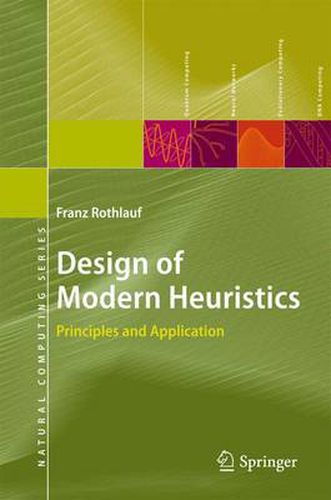Readings Newsletter
Become a Readings Member to make your shopping experience even easier.
Sign in or sign up for free!
You’re not far away from qualifying for FREE standard shipping within Australia
You’ve qualified for FREE standard shipping within Australia
The cart is loading…






This title is printed to order. This book may have been self-published. If so, we cannot guarantee the quality of the content. In the main most books will have gone through the editing process however some may not. We therefore suggest that you be aware of this before ordering this book. If in doubt check either the author or publisher’s details as we are unable to accept any returns unless they are faulty. Please contact us if you have any questions.
Most textbooks on modern heuristics provide the reader with detailed descriptions of the functionality of single examples like genetic algorithms, genetic programming, tabu search, simulated annealing, and others, but fail to teach the underlying concepts behind these different approaches.
The author takes a different approach in this textbook by focusing on the users’ needs and answering three fundamental questions: First, he tells us which problems modern heuristics are expected to perform well on, and which should be left to traditional optimization methods. Second, he teaches us to systematically design the right modern heuristic for a particular problem by providing a coherent view on design elements and working principles. Third, he shows how we can make use of problem-specific knowledge for the design of efficient and effective modern heuristics that solve not only small toy problems but also perform well on large real-world problems.
This book is written in an easy-to-read style and it is aimed at students and practitioners in computer science, operations research and information systems who want to understand modern heuristics and are interested in a guide to their systematic design and use.
This book is written in an easy-to-read style and it is aimed at students and practitioners in computer science, operations research and information systems who want to understand modern heuristics and are interested in a guide to their systematic design and use.
This book is written in an easy-to-read style and it is aimed at students and practitioners in computer science, operations research and information systems who want to understand modern heuristics and are interested in a guide to their systematic design and use.
$9.00 standard shipping within Australia
FREE standard shipping within Australia for orders over $100.00
Express & International shipping calculated at checkout
This title is printed to order. This book may have been self-published. If so, we cannot guarantee the quality of the content. In the main most books will have gone through the editing process however some may not. We therefore suggest that you be aware of this before ordering this book. If in doubt check either the author or publisher’s details as we are unable to accept any returns unless they are faulty. Please contact us if you have any questions.
Most textbooks on modern heuristics provide the reader with detailed descriptions of the functionality of single examples like genetic algorithms, genetic programming, tabu search, simulated annealing, and others, but fail to teach the underlying concepts behind these different approaches.
The author takes a different approach in this textbook by focusing on the users’ needs and answering three fundamental questions: First, he tells us which problems modern heuristics are expected to perform well on, and which should be left to traditional optimization methods. Second, he teaches us to systematically design the right modern heuristic for a particular problem by providing a coherent view on design elements and working principles. Third, he shows how we can make use of problem-specific knowledge for the design of efficient and effective modern heuristics that solve not only small toy problems but also perform well on large real-world problems.
This book is written in an easy-to-read style and it is aimed at students and practitioners in computer science, operations research and information systems who want to understand modern heuristics and are interested in a guide to their systematic design and use.
This book is written in an easy-to-read style and it is aimed at students and practitioners in computer science, operations research and information systems who want to understand modern heuristics and are interested in a guide to their systematic design and use.
This book is written in an easy-to-read style and it is aimed at students and practitioners in computer science, operations research and information systems who want to understand modern heuristics and are interested in a guide to their systematic design and use.